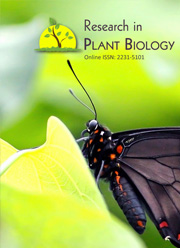Salinity induced changes in ascorbic acid, hydrogen peroxide, lipid peroxidation and glutathione content in leaves of salt tolerant and salt-susceptible cultivars of cotton (Gossypium hirsutum L.)
Keywords:
Ascorbate, hydrogen peroxide, malondialdehyde, NaCl, salt-stressAbstract
The present study was carried out to investigate the effect of NaCl salinization onascorbate content, hydrogen peroxide content and lipid peroxidation in seedlings of saltsensitive(H-1236) and salt-tolerant (H-1226) American cotton genotypes. A nonsignificantchange was observed in ascorbate content in salt-tolerant (H-1226) genotypewhen exposed to salt stress, while there was a significant increase of 33.7% in sensitivegenotype (H-1236). Enhancement in hydrogen peroxide content was observed in both thegenotypes upon NaCl treatment. The basal level of hydrogen peroxide content was higherin sensitive genotype (87.2 μmoles/gFW) as compared to the tolerant genotype (67.9μmoles/gFW). The leaves of both the genotypes showed higher level of malondialdehydecontent when subjected to salt stress, however, the extent of enhancement was more insensitive genotype (182%) as compared to that in tolerant genotype (140%).Downloads
Download data is not yet available.
Published
08-04-2013
How to Cite
Kumari, N., Jain, V., & Talwar, G. (2013). Salinity induced changes in ascorbic acid, hydrogen peroxide, lipid peroxidation and glutathione content in leaves of salt tolerant and salt-susceptible cultivars of cotton (Gossypium hirsutum L.). Research in Plant Biology, 3(2). Retrieved from https://www.updatepublishing.com/journal/index.php/ripb/article/view/2517
Issue
Section
Articles



 .
. 